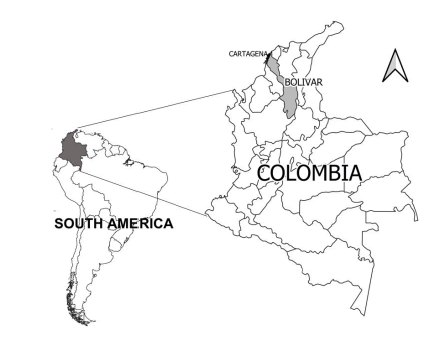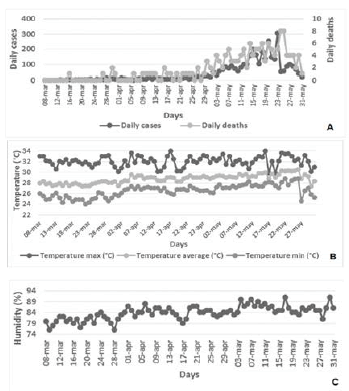Short communication
, Volume: 0( 0)Correlation between temperature and humidity with COVID-19 pandemic in Cartagena, Colombia
- *Correspondence:
- Eder Cano-Perez, University of Cartagena, Faculty of Medicine, Laboratory of Tropical Medicine, Cartagena de Indias, Colombia, Tel: +573006741092; E-mail:ecanop@unicartagena.edu.co
Received: July 29, 2020; Accepted: August 13, 2020; Published: August 20, 2020
Citation: Eder Cano-Pérez, Correlation between temperature and humidity with COVID-19 pandemic in Cartagena, Colombia, J Environ Sci. 16 (4).124
Keywords
Corona virus; COVID-19; Temperature; Humidity; Colombia
Abstract
Different climatic and environmental factors influence the epidemiological behavior of infectious diseases. This study aims to analyze the correlation between climate and COVID-19 cases in Cartagena, Colombia. Epidemiological and meteorological data were collected from the surveillance files of COVID-19 of the Colombian Ministry of Health and the meteorological station of the Center for Oceanographic and Hydrographic Research of Cartagena. Climatic factors included: minimum temperature (°C), maximum temperature (°C), average temperature (°C), and relative humidity (%). Spearman's rank correlation test was used to examine the correlation between climatic and epidemiological variables. Among the climatic components, the average temperature, minimum temperature, and relative humidity were significantly correlated with the incidence of COVID-19. These findings may contribute to the implementation of preventive actions against COVID-19 disease in Colombia.
Introduction
Currently, a large number of nations worldwide are battling a viral pandemic caused by the new corona virus, SARS-CoV-2, the causative agent of the disease named COVID-19. The COVID-19 pandemic in Colombia, according to a statement from the Ministry of Health of June 25, 2020, reported 240.745 cases and 8.269 deaths; The capital Bogota, with 81.180 cases, have the highest number of infections, occupying approximately 33.72% of the total number of infections in the country [1]. In the northern region of Colombia, the situation is not good either, one of the most outstanding examples is city Cartagena, that since its first case identified on March 8, 2020 it has maintained exponential growth in its rate of infections, totaling 14.258 cases and 440 deaths until July 25, 2020, positioning itself as one of the most infected cities in Colombia. Also, it was the first city to report a death associated with COVID-19 in the country.
Different factors influence the epidemiological behavior of infectious or communicable diseases, among them, environmental components. Historically, different studies have examined environmental factors that could influence the spread of respiratory viruses. During the SARS-CoV outbreak, the incidence of the disease was identified to be higher at lower air temperatures than at higher temperatures [2]. Likewise, it has been reported that the incidence of influenza increases significantly with low temperatures and low or high relative humidity [3]. In the case of SARS-CoV-2, colder environments have been reported to facilitate COVID-19 transmission and mortality and that the virulence of the agent deteriorates at higher temperatures, indicating that climatic factors can significantly affect transmission viral [4,5]. Considering the background in the literature, we decided to study the possible associations between climatic factors (such as temperature and humidity) and SARS-CoV-2 transmission and COVID-19 mortality in the city of Cartagena, Colombia.
Materials and Methods
Study site
Cartagena city is the capital of the state of Bolívar located in northern Colombia (10°23'59'' N 75°30.866' O) (FIG. 1) and has been described as historical and cultural patrimony of humanity since 1984. The population of Cartagena in 2018 was 887.946 habitants; in 2020, the population was estimated to increase to 1.028.736 based on population projections from the 2018 Population Census [6].
Data collection
The data set was taken from March 8 to May 31, 2020, due to limited weather information. The meteorological data (maximum, average and minimum temperature, and humidity) were taken from the meteorological station of the Center for Oceanographic and Hydrographic Research located in Cartagena. Epidemiological information was obtained from the surveillance files of COVID-19 of the National Ministry of Health.
Statistical analysis
As data were not normally distributed, Spearman's rank correlation test was used to examine the relationship between climatic and epidemiological variables using SPSS v.19.0. Statistical significance was defined as (p<0.05).
Results and Discussion
In the period analyzed in this study (March 8 to May 31, 2020), there were 3,475 cases of COVID-19 and 156 deaths in Cartagena. In general, a strong increase in cases and deaths was observed during May (FIG. 2A). From the first week from March 8 to April 30, the confirmed cases were 361, which increased to 746 until the first week on May 7, 1406 in the second week, 2590 until the end of the third week, and 3547 until May 31, 2020. As for the climatic values, the maximum, minimum, and average temperatures varied from 29.8° C to 34.0° C; 24.0° C to 28.8° C and 27.3° C to 30.5 ° C, respectively (FIG. 2B). The lowest mean humidity was 76% (with the highest mean humidity 91%) (FIG. 2C). Spearman's correlation test showed a significant correlation between average temperature, minimum temperature, and humidity with COVID-19 transmission and mortality (FIG. 2 and TABLE 1).
| Climatic variables | Daily cases | Daily mortality |
|---|---|---|
| Temperatura max (°C) | 0,147 | 0,185 |
| Temperatureaverage (°C) | 0,746 * | 0,704 * |
| Temperatura min (°C) | 0,704 * | 0,674 * |
| RelativeHumidity (%) | 0,565 * | 0,558 * |
Table 1. Spearman's correlation between COVID-19 and climatic variables. *: Correlation is significant at the 0.001 level.
Figure 2: (A) Cases and deaths from COVID-19. (B) Maximum, average and minimum temperature. (C) Relative humidity.
In the present study, the relationship between COVID-19 incidence and climatic factors in the city of Cartagena was analyzed. Our findings establish that the minimum temperature, average temperature, and relative humidity are correlated with COVID-19 occurrence and mortality of COVID-19 in Cartagena, with the lowest minimum temperature of 24°C and the highest average temperature of 27.3°C; and humidity range between 76% and 91%. These results are consistent with other studies reported in the literature. In reference, Tesopu et al, in Jakarta, Indonesia, found a correlation between average temperature and COVID-19 cases, with an average temperature range between 26.1°C and 28.6°C [7]. Similarly, a study conducted during the SARS-CoV outbreak in China reported that the optimal ambient temperature associated with cases was between 16°C and 28°C [8]. In New York, they found an association between minimum temperature and mean temperature with new cases, confirmed total cases, and COVID-19 mortality [9].
Various studies have supported the hypothesis that cold and dry environments favor COVID-19 transmission and mortality, proposing that warm weather will play an important role in suppressing the virus [4,5]. However, some authors point out that high temperatures will not necessarily lead to a decrease in the outbreak unless extensive public health interventions are implemented [10,11]. Also, it has been reported that the influence of temperature and humidity contribute in less than 20% of the variation in the duplication of COVID-19 cases, the remaining 80% is related to other factors such as containment measures, general health policies, density population, transportation and cultural aspects [11].
In Cartagena, additionally to climate, the increase in COVID-19 cases can also be caused by social reasons. First, there is a violation of the measures of isolation and social distancing by the population, especially by the most economically needy people, who are forced to leave their homes in search of basic sustenance. According to the latest national census, Cartagena is positioned as the first city with the lowest unemployment rate in Colombia (11.7%). However, these values should not be seen on its own, because although 88% of the people of Cartagena are employed, about 56.1% of them are in informal employment and without guarantees, which may mean that more than half of the inhabitants could have unstable working conditions and income, which often do not provide opportunities to work from home.
Conclusion
In conclusion, the results of this preliminary study show a correlation between climatic indicators such as temperature and humidity on the epidemiology of COVID-19 in Cartagena, which could contribute to the implementation of preventive actions against the disease. The current study is exploratory and offers some limitations. First, other environmental and climatic factors were not considered due to the lack of data in the meteorological station; likewise, the climatic information of the analyzed variables is limited as of May 31, 2020. Additionally, other social variables such as personal hygiene and social distancing should not be underestimated and should be included in subsequent studies. Therefore, the execution of additional studies is required to complement the data presented here.
References
- Instituto Nacional de Salud (INS). Coronavirus (COVID-19) en Colombia.
- Lin KUN, Fong D, Zhu B. Environmental factors on the SARS epidemic: air temperature, passage of time and multiplicative effect of hospital infection. Epidemiol Infect. 2005;134(2):223-30.
- Park J-E, Son W-S, Ryu Y. Effects of temperature, humidity, and diurnal temperature range on influenza incidence in a temperate region. Influenza Other Respir Viruses. 2020;14(1):11-8.
- Ma Y, Zhao Y, Liu J, et al. Effects of temperature variation and humidity on the death of COVID-19 in Wuhan, China. Sci Total Environ. 2020;724:138226.
- Wang J, Tang K, Fng K et al. High temperature and high humidity reduce the transmission of COVID-19.
- Tosepu R, Gunawan J, Effendy DS, et al. Correlation between weather and Covid-19 pandemic in Jakarta, Indonesia. Sci Total Environ. 2020;725:138436.
- Tan J, Mu L, Huang J, et al. An initial investigation of the association between the SARS outbreak and weather: with the view of the environmental temperature and its variation. J Epidemiol Community Health. 2005;59(3):186.
- Bashir MF, Ma B, Bilal, et al. Correlation between climate indicators and COVID-19 pandemic in New York, USA. Sci Total Environ. 2020;728:138835.
- Luo W, Majumder MS, Liu D, et al. The role of absolute humidity on transmission rates of the COVID-19 outbreak.
- Oliveiros B, Caramelo L, Ferreira NC. Role of temperature and humidity in the modulation of the doubling time of COVID-19 cases.
- Medición de empleo informaly seguridad social: trimestre móvil diciembre 2019-febrero 2020.



